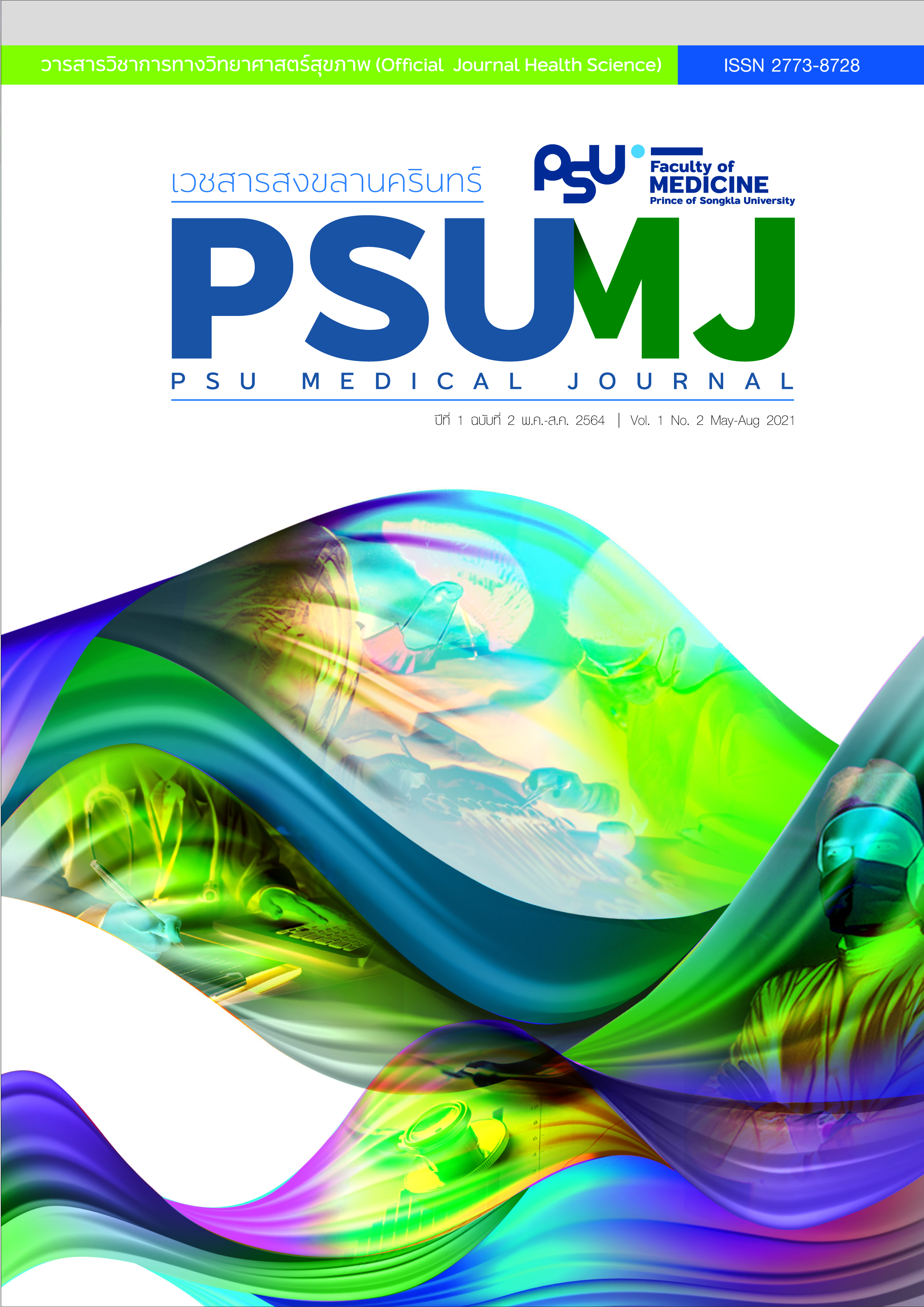Postpartum Pap Smear Results in Women with Abnormal Pap Smears Detected at First Antenatal Care: A Retrospective Study in a Songklanagarind Hospital
Pap Smears in Pregnancy
DOI:
https://doi.org/10.31584/psumj.2021246515Keywords:
outcome, pap, pregnancyAbstract
Objective: To assess the remission rate at postpartum periods of abnormal Pap smears during pregnancy, and to identify the demographic and clinical characteristics of pregnant women with abnormal Pap smears.
Material and Methods: Pregnant women, who had antenatal care (ANC) in Songklanagarind Hospital in period of January 2011 to December 2019, were identified retrospectively. Exclusion criteria included inaccessible results of Pap smears during pregnancy and postpartum periods. Medical records of all pregnant women with abnormal Pap smears were reviewed. The association between Pap smear results during pregnancy and postpartum were analyzed by Cramer’s V statistic ranging from 0 to 1, with a 1 indicating perfect association.
Results: Of these 8,238 pregnant women had available Pap smear results, 109 (1.3%) women were shown with abnormal results. The most common of abnormality from Pap smears were atypical squamous cells of undetermined significance. In postpartum period, 50 women who had abnormal Pap smear during pregnancy, underwent postpartum follow-up examination at six weeks postpartum, respectively. The majority of results (84.0%) were normal whilst rate of remission occurred in 45 women (90.0%). The association of Pap smears between during pregnancy and postpartum was shown to have a small association (Cramer’s V = 0.2).
Conclusion: There was low prevalence of abnormal Pap smear during pregnancy and high remission rate at postpartum. However, health care providers should be aware of cervical cancer screening in all pregnant women, because many women had not undergone cervical cancer screening before pregnancy.
References
Tewari KS. Cancer in Pregnancy. In: Disaia PJ, Creasman WT, Mannel RS, Mcmeekin DS, Mutch DG, editors. Clinical Gynecologic Oncology. 9th ed. Philadelphia: Elsevier 2018; p.353-418.
Yang KY. Abnormal pap smear and cervical cancer in pregnancy. Clin Obstet Gynecol 2012;55:838-48.
Kunos CA, Abdul-Karim FW, Dizon DS, Debernardo R. Cervix uteri. In: Chi DS, Berchuck A, Dizon DS, Yashar CM, editors. Principles and Practice of Gynecologic Oncology. 7th ed. Philadelphia: Wolters Kluwer; 2017;p467-510.
Flannelly G. The management of women with abnormal cervical cytology in pregnancy. Best Pract Res Clin Obstet Gynaecol 2010;24:51-60.
Coppola A, Sorosky J, Casper R, Anderson B, Buller RE. The Clinical Course of Cervical Carcinomain SituDiagnosed during Pregnancy. Gynecol Oncol 1997;67:162-5.
Amant F, Ungar L. Cancer in Pregnancy. In: Berek JS, Hacker NF, editors. Berek & Hacker’s Gynecologic Oncology. 6th ed. Philadelphia: Wolters Kluwer; 2015. p.692-704.
Perkins RB, Guido RS, Castle PE, Chelmow D, Einstein MH, Garcia F, et al. 2019 ASCCP Risk-Based Management Consensus Guidelines for Abnormal Cervical Cancer Screening Tests and Cancer Precursors. J Low Genit Tract Dis 2020; 24:102-31.
Broderick D, Matityahu D, Dudhbhai M, Alter S. Histologic and colposcopic correlates of ASCUS pap smears in pregnancy. J Low Genit Tract Dis 2002;6:116-9.
Dunn TS, Bajaj JE, Stamm CA, Beaty B. Management of the minimally abnormal papanicolaou smear in pregnancy. J Low Genit Tract Dis 2001;5:133-7.
Wu YM, Wang T, He Y, Song F, Wang Y, Zhu L, et al. Clinical management of cervical intraepithelial neoplasia in pregnant and postpartum women. Arch Gynecol Obstet 2014;289:1071-7.
Yost NP, Santoso JT, McIntire DD, Iliya FA. Postpartum regression rates of antepartum cervical intraepithelial neoplasia II and III lesions. Obstet Gynecol 1999;93:359-62.
Serati M, Uccella S, Laterza RM, Salvatore S, Beretta P, Riva C, et al. Natural history of cervical intraepithelial neoplasia during pregnancy. Acta Obstet Gynecol Scand. 2008;87:1296- 300.
Khaengkhor P, Mairaing K, Suwannarurk K, Thaweekul Y, Poomtavorn Y, Pattaraarchachai J, et al. Prevalence of ab normal cervical cytology by liquid based cytology in the ante natal care clinic, Thammasat University Hospital. J Med Assoc Thai 2011;94:152-8.
Lertcharernrit J, Sananpanichkul P, Suknikhom W, Bhamarapravatana K, Suwannarurk K, Leaungsomnapa Y. Prev lence and Risk Assessment of Cervical Cancer Screening by Papanicolaou Smear and Visual Inspection with Acetic Acid for Pregnant Women at a Thai Provincial Hospital. Asian Pac J Cancer Prev 2016;17:4163-7.
Chichareon SB, Tassee S, Wootipoom V, Buhachat R, Harnprasertpong J. Situation analysis for management of abnormal Pap smears in the lower southern Thailand. Asian Pac J Cancer Prev 2005;6:286-94.
Kantathavorn N, Kietpeerakool C, Suprasert P, Srisomboon J, Khunamornpong S, Nimmanhaeminda K, et al. Clinical relevance of atypical squamous cells of undetermined sig nificance by the 2001 bethesda system: experience from a cervical cancer high incidence region. Asian Pac J Cancer Prev 2008;9:785-8.
Solomon D, Davey D, Kurman R, Moriarty A, O’Connor D, Prey M, et al. The 2001 Bethesda System: terminology for reporting results of cervical cytology. JAMA 2002;287:2114-9.
Kaplan KJ, Dainty LA, Dolinsky B, Rose GS, Carlson J, McHale M, et al. Prognosis and recurrence risk for patients with cervical squamous intraepithelial lesions diagnosed during pregnancy. Cancer 2004;102:228-32.
Mangiafico SS. Summary and Analysis of Extension Program Evaluation in R. 2016 [Monograph on the Internet] New Brunswick: Rutgers Cooperative Extension [cited 2029 November 5]. Available from: https://rcompanion.org/handbook/
Hong JN, Berggren EK, Campbell SL, Smith JS, Rahangdale L. Abnormal cervical cancer screening in pregnancy and preterm delivery. Paediatr Perinat Epidemiol 2014;28:297-301.
Erickson BK, Einstein MH, Huh WK. Preinvasive Disease of the Lower Genital Tract. In: Chi dS, Berchuck A, Dizon DS, Yashar CM, editors. Principles and Practice of Gynecologic Oncology. 7th ed. Philadelphia: Wolters Kluwer; 2017. p.114-29.
Kyrgiou M, Mitra A, Arbyn M, Stasinou SM, Martin-Hirsch P, Bennett P, et al. Fertility and early pregnancy outcomes after treatment for cervical intraepithelial neoplasia: systematic review and meta-analysis. BMJ 2014;349:g6192.
Jin G, LanLan Z, Li C, Dan Z. Pregnancy outcome following loop electrosurgical excision procedure (LEEP) a systematic review and meta-analysis. Arch Gynecol Obstet 2014;289:85-99.
Bjorge T, Skare GB, Bjorge L, Trope A, Lonnberg S. Averse Pregnancy Outcomes After Treatment for Cervical Intraepithelial Neoplasia. Obstet Gynecol 2016;128:1265-73.
Siegler E, Lavie O, Amit A, Vaknin Z, Auslander R, Blumenfeld Z. Should the Risk of Invasive Cancer in Pregnancy and the Safety of Loop Electrosurgical Excision Procedure During the First 15 Weeks Change Our Practice? J Low Genit Tract Dis 2017;21:299-303.
Cubo-Abert M, Centeno-Mediavilla C, Franco-Zabala P, Merced-Vazquez C, Castellvi J, Garcia A, et al. Risk factors for progression or persistence of squamous intraepithelial lesions diagnosed during pregnancy. J Low Genit Tract Dis 2012;16:34-8.
Suzuki K, Furuhashi M, Kawamura T, Kubo M, Osato K, Yamawaki T. Comparing Papanicolaou test results obtained during pregnancy and post-partum. J Obstet Gynaecol Res 2017;43:705-9.
Ahdoot D, Van Nostrand KM, Nguyen NJ, Tewari DS, Kurasaki T, DiSaia PJ, et al. The effect of route of delivery on regression of abnormal cervical cytologic findings in the postpartum period. Am J Obstet Gynecol 1998;178:1116-20.
Chung SM, Son GH, Nam EJ, Kim YH, Kim YT, Park YW, et al. Mode of delivery influences the regression of abnormal cervical cytology. Gynecol Obstet Invest 2011;72:234-8.








